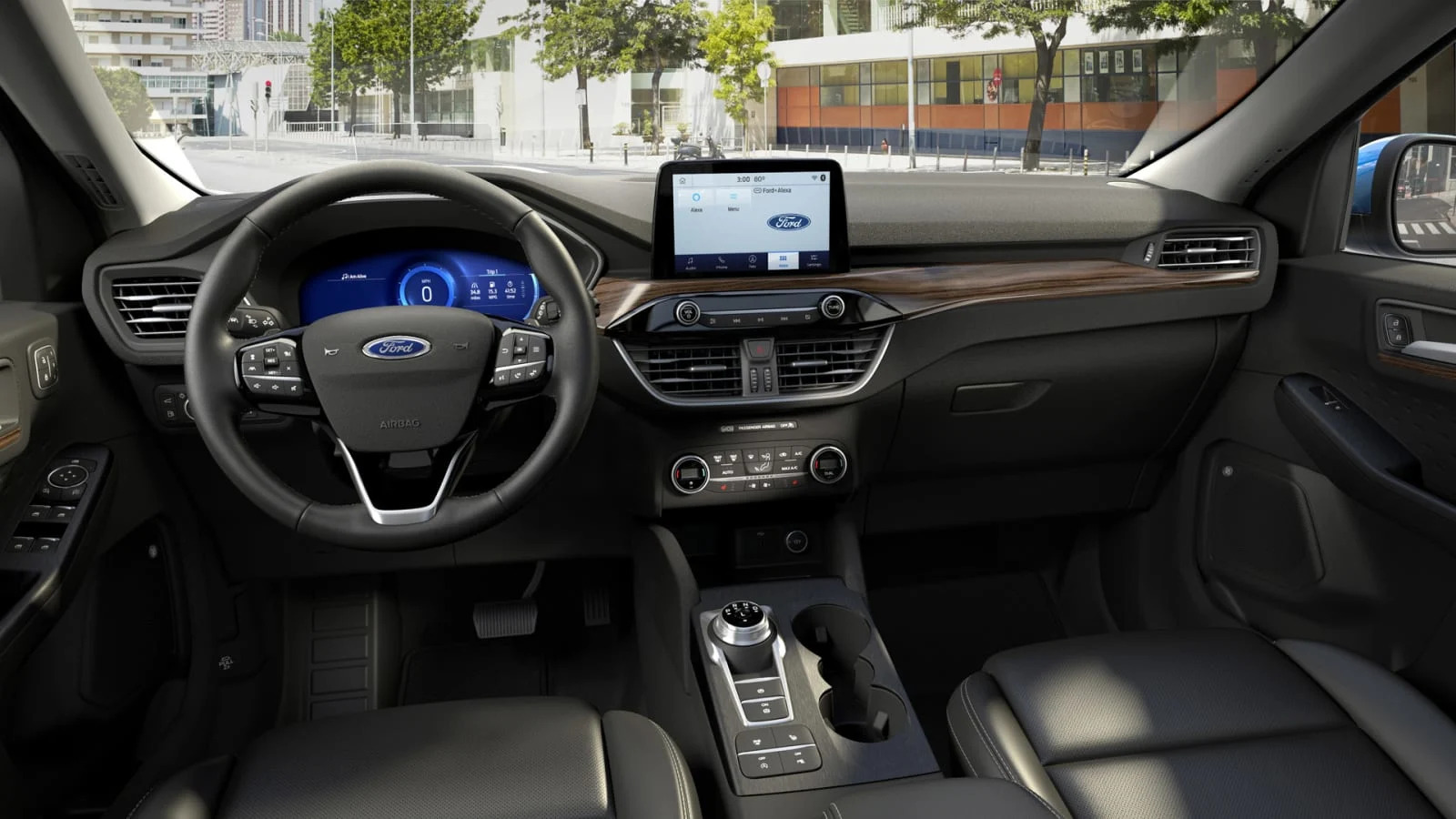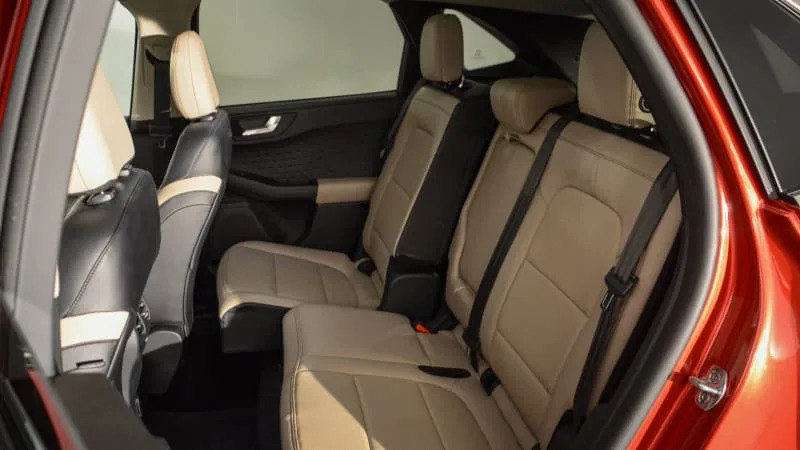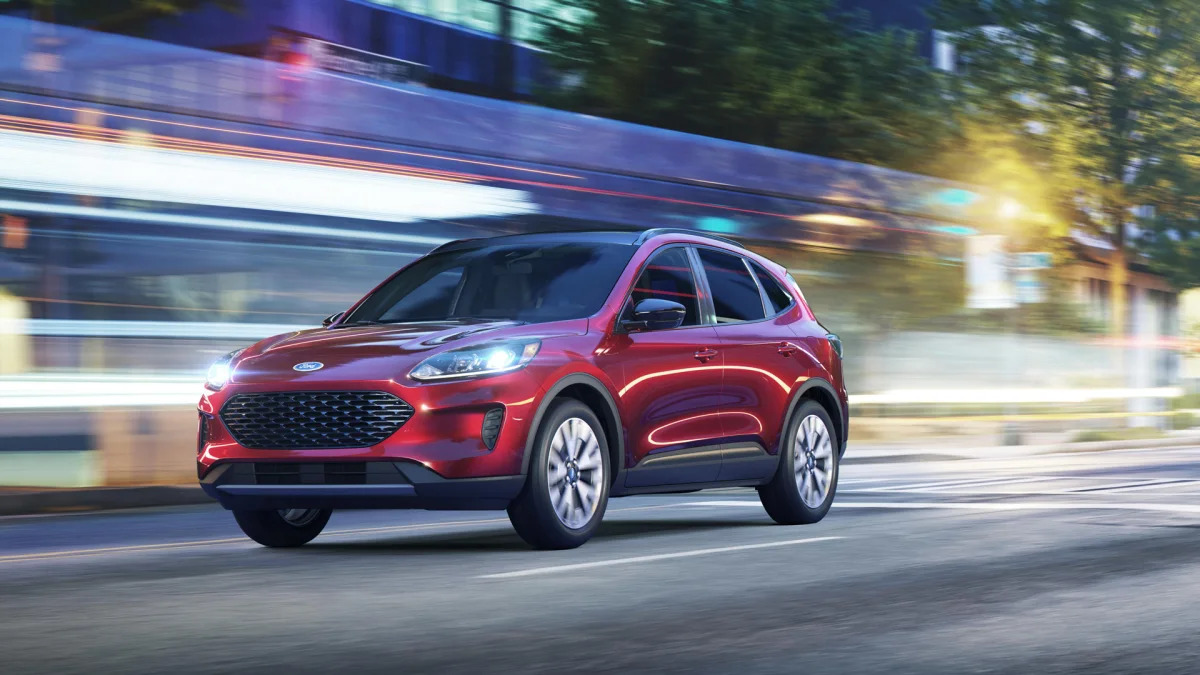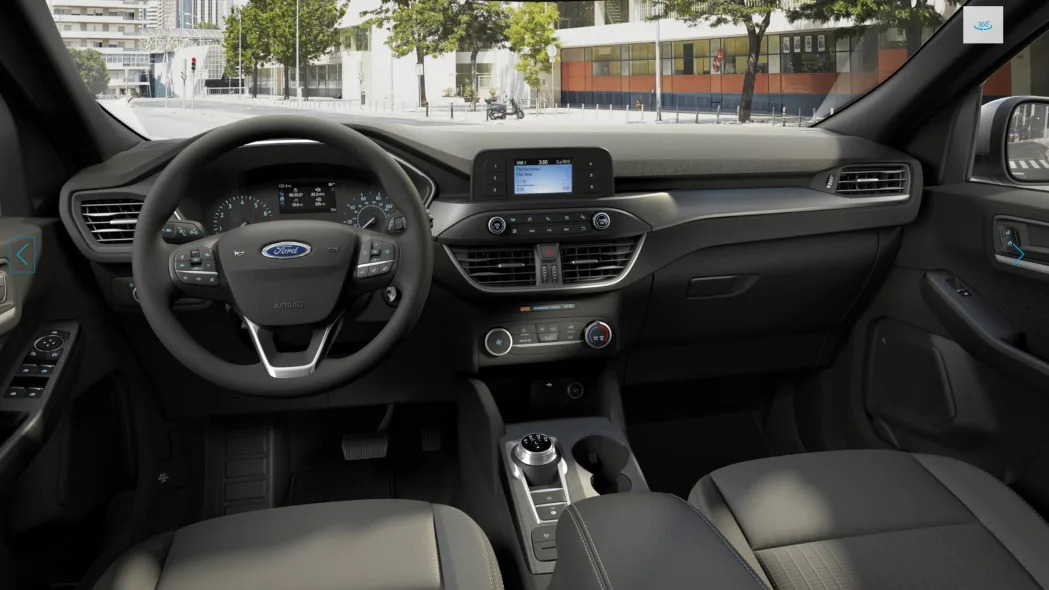-
TrimTitanium
-
Engine2.0L Turbo I4
-
Power250 HP / 275 LB-FT
-
Transmission8-Speed Auto
-
DrivetrainFWD / AWD
-
Engine PlacementFront
-
Curb Weight3,399 LBS
-
Towing3,500 LBS
-
Seating2+3
-
Cargo65.4 CU-FT Maximum
-
Base Price$26,080
-
As Tested Price$37,480
LOUISVILLE, Ky. — The all-new 2020 Ford Escape comes at an interesting time for Ford. By dropping its sedan and hatchback lines in the U.S., Ford is hoping (and frankly, betting) that its lineup of completely re-conceived crossovers and SUVs, like the significantly improved, all-new 2020 Ford Explorer, will absorb those car buyers and attract new ones. To that end, the reborn Escape is more car-like in appearance than before, riding on the same platform as the next-generation Focus we'll never get, and looking more like a jacked-up hatchback than anything that might tackle an off-road adventure. It’s handsome, but it is also the opposite of the direction Toyota took with its sales-leading RAV4, which adopted a more rugged look and feel in its most recent redesign.
By making the Escape even less like a truck and even more like a car, Ford aims to offer its customers the best of both worlds — the driving dynamics of a fun hatchback with the elevated seating position that American buyers want. And for the most part, it’s successful in that mission.
Visualizing the 2020 Escape’s car-ification requires no more than a quick glance at its sheetmetal, particularly at the front. Ford says the trapezoidal shape of the Escape's grille opening is inspired by the Mustang and that its lower front fascia borrows design cues from the GT supercar — tellingly, there’s no mention of Ford’s sales-leading pickup trucks in the design discussion. The roof slopes dramatically toward the rear of the vehicle, which makes the latest Escape look like a highly aerodynamic lozenge when viewed in profile. It also means rearward visibility over the driver’s shoulder is basically nonexistent.



Inside, the 2020 Escape has some fancy and eye-catching optional technology to help set it apart from its competitors. We like the available 12.3-inch digital instrument cluster, in part because it offers more than just a replication of traditional gauges and dials. The cluster is configurable, and it offers a different visual representation for each available drive mode — Normal, Sport, Eco, Slippery, and Snow and Sand. There’s also a 6-inch head-up display that unfolds from the top of the dashboard to put relevant information directly in the driver’s line of sight.
The 2020 Escape is roomy inside, particularly in the back seat. The second row now slides 6 inches fore and aft, and in its rearmost position, offers a class-leading 40.7 inches of legroom. In the real world, that means a 6-footer will have no problem getting comfortable in the back seat behind another 6-footer in the front. If you position those rear seats as far forward as they’ll go, thereby significantly reducing rear legroom, there’s as much as 33.5 cubic-feet behind them. That's less than the outgoing Escape's 34 cubic-feet, which was available with the seat in its fixed and therefore rearmost position. A Honda CR-V and Subaru Forester also have more with their fixed seats raised as well as lowered. The new Escape's maximum cargo space is 65.4 cubic-feet, which is average for the segment, but about 10 cubes shy of the Honda and Subaru. The outgoing Escape's maximum is 68 cubic-feet. At least the 2020 Escape's cargo area is well-shaped and accessible — we saw Ford put four full sets of golf clubs and bags in the back of an Escape, and there was room for more.
While its space utilization is good, we have some complaints about the new Escape’s interior detailing. Most everything the driver will regularly come into contact with is of reasonable and competitive quality, but between those touch points are some iffy bits. Particularly annoying are the door panels molded out of a sort of squishy foam-like plastic, and rigid sun visors that impede too much of the view forward when in use.
The 2020 Escape’s base 1.5-liter turbocharged engine is the segment's only three-cylinder. It spins out 181 horsepower and 190 pound-feet of torque, which puts it roughly on par or better than the CR-V and Subaru Forester. Whereas those competitors use continuously variable transmissions, Ford sticks with a conventional eight-speed automatic. That’s good news for most driving situations, as the gearbox feels smooth and responsive in normal driving duties. Where this small-displacement engine falls flat, though, is power right off idle. It’s not until about 10 mph or so until the turbo really gets spinning and the power starts to build. Until that happens, the driver is keenly aware that there are only three relatively small pistons cranking away under the Escape’s hood. To put it bluntly, it’s decidedly slow when moving off from a stop – but once it hits its groove, it’s adequate.
Buyers who want a bit more oomph (and cylinders) can opt for a 2.0-liter turbocharged inline-four that offers 250 horsepower and a class-leading 280 lb-ft on premium fuel. It’ll run fine on regular gas but will make a little less power. The bigger engine is also hooked up to an eight-speed automatic, and while it’s certainly quicker than its 1.5-liter sibling, even the larger engine option is sometimes caught flat-footed at low RPMs until the boost builds. Once under way, passing power from the 2.0-liter is very good due to its abundance of midrange torque, and it’s rated to tow as much as 3,500 pounds.
An optional all-wheel drive system features rear wheels that disconnect from the rest of the drivetrain until the car’s computer senses slip, which helps reduce fuel consumption. The EPA rates Escapes powered by the 1.5-liter at 27 city, 33 highway, and 30 combined with front-wheel drive or 26/31/28 with all-wheel drive. The all-wheel-drive 2.0-liter is rated at 23/31/26. For the sake of comparison, then most efficient last-gen Escape used a 1.5-liter four-cylinder engine and was rated at 23 city, 30 highway, and 26 combined, so the new powertrains are major improvements over the old.
There’s a brand-new Escape Hybrid, too, and we’ll tell you about that one in a couple more days. A plug-in hybrid will come next year.
The 2020 Escape is more than 200 pounds lighter than the 2019 model, despite being slightly larger in nearly every meaningful dimension. That reduction in mass pays dividends out on the road, where the Escape feels confident and surefooted. It’s not as fun to toss around as the enthusiast-favorite Mazda CX-5, but the chassis is stiff and the suspension is just on the firm side of comfortable (much as the outgoing Escape's was), making it one of the more engaging options in its segment. As is the case with most modern compact crossovers, the Escape’s steering is overboosted and light but not egregiously so.
Really, the 2020 Escape drives more like a Focus that’s been jacked up a few extra inches off the ground – because that’s exactly what it is. The outgoing Escape could be described similarly as it too was mechanically based on a Focus, but for 2020, the dial has been turned even further toward "car." Ford is hoping this change will capture a large percentage of buyers who would otherwise be lost by the death of the Focus and the impending death of the Fusion. However, that leads us to the Escape’s price.
The 2020 Escape starts at $26,080 in base S trim (including a $1,195 destination charge), which comes standard with Ford’s Co-Pilot 360 safety tech package that includes lane-keep assist and automatic emergency braking. That’s right on par for the segment, but much higher than the $21,415 asking price of the now-dead Focus or even the $24,165 for a base 2020 Fusion S. Obviously, the Escape’s pricing rises from there. An Escape SE with Ford’s Sync 3 infotainment system, which includes an 8-inch screen along with Android Auto and Apple CarPlay, costs $28,290. All-wheel drive is optional on most models for a $1,500 surcharge. If you want the 2.0-liter EcoBoost, which comes standard with all-wheel drive, an SEL will run $33,835 and a range-topping Escape Titanium costs $37,480.
Now, there's another reason for this extra car-like direction and the lack of an off-road-oriented trim level. Rather than offering something similar to the Toyota RAV4 Adventure, Ford will soon offer a separate, more rugged compact crossover to fill that niche, something we’ve been calling the “Baby Bronco.” We expect that it’ll wear boxy sheetmetal and offer some light-duty off-road capabilities, in the vein of the Jeep Compass Trailhawk. That strategy lets the Escape specialize as a car-like vehicle with swoopy styling and kinda-sorta sporty driving dynamics, while the Baby Bronco will be more rugged and truck-like. What neither of them seems likely to do, however, is fill the void in price point left by the loss of the significantly less expensive Focus.
Americans have shown that they love crossovers, but they also love a bargain. And while the 2020 Escape is a good product that will likely win over plenty of customers and dovetail nicely with the upcoming Baby Bronco, there’s an awfully big gap between the $21,090 EcoSport and a $26,080 Escape. And really, the EcoSport isn’t a particularly desirable product, regardless of price.
But standing on its own, the 2020 Escape is a crossover that owners are going to like. It’s a much better vehicle than the Escape it replaces, benefiting greatly from its next-generation Euro-Focus chassis and more fuel-efficient engine options. And, with the caveat that we don’t yet know if the Escape’s more adventurous Bronco-inspired sibling will be similarly successful in its mission and execution, it seems that Ford’s two-pronged compact crossover strategy is off to a good start.














Sign in to post
Please sign in to leave a comment.
Continue